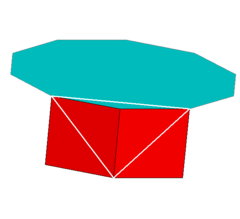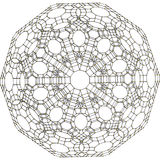
In geometry, the gyroelongated pentagonal rotunda is one of the Johnson solids (J25). As the name suggests, it can be constructed by gyroelongating a pentagonal rotunda (J6) by attaching a decagonal antiprism to its base. It can also be seen as a gyroelongated pentagonal birotunda (J48) with one pentagonal rotunda removed.
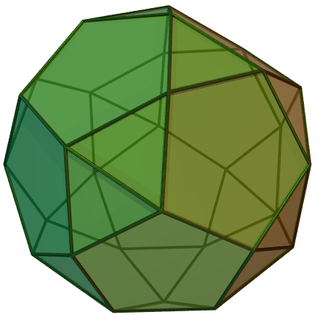
In geometry, the pentagonal orthobirotunda is one of the Johnson solids (J34). It can be constructed by joining two pentagonal rotundae (J6) along their decagonal faces, matching like faces.

In geometry, the elongated pentagonal gyrobirotunda is one of the Johnson solids (J43). As the name suggests, it can be constructed by elongating a "pentagonal gyrobirotunda," or icosidodecahedron, by inserting a decagonal prism between its congruent halves. Rotating one of the pentagonal rotundae (J6) through 36 degrees before inserting the prism yields an elongated pentagonal orthobirotunda (J42).

In geometry, the elongated pentagonal orthobirotunda is one of the Johnson solids (J42). Its Conway polyhedron notation is at5jP5. As the name suggests, it can be constructed by elongating a pentagonal orthobirotunda (J34) by inserting a decagonal prism between its congruent halves. Rotating one of the pentagonal rotundae (J6) through 36 degrees before inserting the prism yields the elongated pentagonal gyrobirotunda (J43).
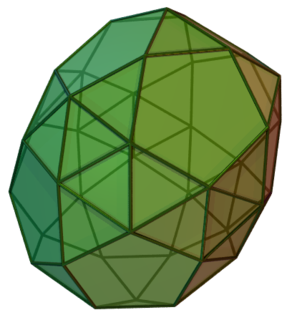
In geometry, the gyroelongated pentagonal birotunda is one of the Johnson solids (J48). As the name suggests, it can be constructed by gyroelongating a pentagonal birotunda by inserting a decagonal antiprism between its two halves.
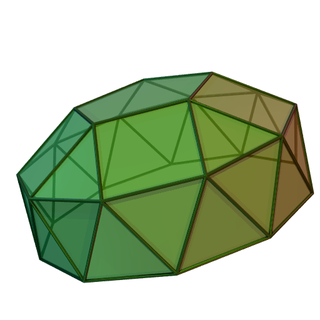
In geometry, the gyroelongated pentagonal cupola is one of the Johnson solids (J24). As the name suggests, it can be constructed by gyroelongating a pentagonal cupola (J5) by attaching a decagonal antiprism to its base. It can also be seen as a gyroelongated pentagonal bicupola (J46) with one pentagonal cupola removed.

In geometry, the elongated pentagonal orthobicupola is one of the Johnson solids (J38). As the name suggests, it can be constructed by elongating a pentagonal orthobicupola (J30) by inserting a decagonal prism between its two congruent halves. Rotating one of the cupolae through 36 degrees before inserting the prism yields an elongated pentagonal gyrobicupola (J39).

In geometry, the elongated pentagonal gyrobicupola is one of the Johnson solids (J39). As the name suggests, it can be constructed by elongating a pentagonal gyrobicupola (J31) by inserting a decagonal prism between its congruent halves. Rotating one of the pentagonal cupolae (J5) through 36 degrees before inserting the prism yields an elongated pentagonal orthobicupola (J38).
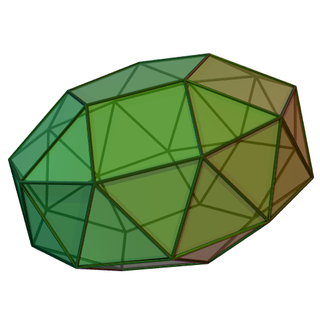
In geometry, the gyroelongated pentagonal bicupola is one of the Johnson solids (J46). As the name suggests, it can be constructed by gyroelongating a pentagonal bicupola by inserting a decagonal antiprism between its congruent halves.

In geometry, the elongated pentagonal gyrocupolarotunda is one of the Johnson solids (J41). As the name suggests, it can be constructed by elongating a pentagonal gyrocupolarotunda (J33) by inserting a decagonal prism between its halves. Rotating either the pentagonal cupola (J5) or the pentagonal rotunda (J6) through 36 degrees before inserting the prism yields an elongated pentagonal orthocupolarotunda (J40).
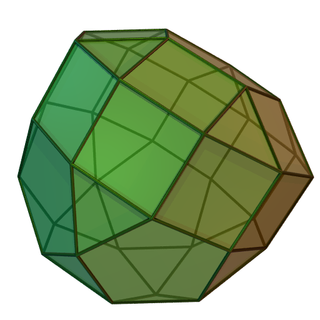
In geometry, the elongated pentagonal orthocupolarotunda is one of the Johnson solids (J40). As the name suggests, it can be constructed by elongating a pentagonal orthocupolarotunda (J32) by inserting a decagonal prism between its halves. Rotating either the cupola or the rotunda through 36 degrees before inserting the prism yields an elongated pentagonal gyrocupolarotunda (J41).

In geometry, the gyroelongated pentagonal cupolarotunda is one of the Johnson solids (J47). As the name suggests, it can be constructed by gyroelongating a pentagonal cupolarotunda by inserting a decagonal antiprism between its two halves.
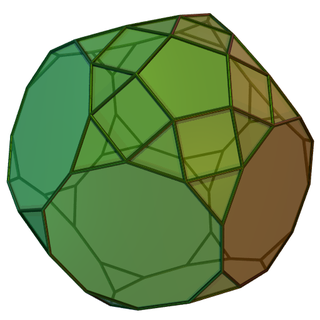
In geometry, the augmented truncated dodecahedron is one of the Johnson solids (J68). As its name suggests, it is created by attaching a pentagonal cupola (J5) onto one decagonal face of a truncated dodecahedron.

In geometry, the parabiaugmented truncated dodecahedron is one of the Johnson solids (J69). As its name suggests, it is created by attaching two pentagonal cupolas (J5) onto two parallel decagonal faces of a truncated dodecahedron.
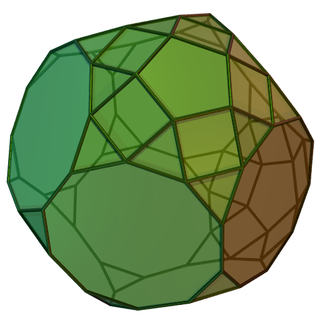
In geometry, the metabiaugmented truncated dodecahedron is one of the Johnson solids (J70). As its name suggests, it is created by attaching two pentagonal cupolas (J5) onto two nonadjacent, nonparallel decagonal faces of a truncated dodecahedron.
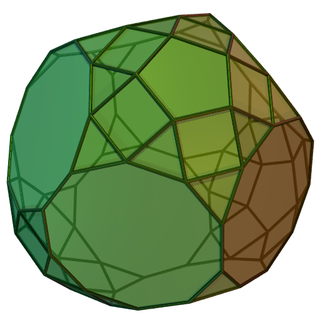
In geometry, the triaugmented truncated dodecahedron is one of the Johnson solids (J71); of them, it has the greatest volume in proportion to the cube of the side length. As its name suggests, it is created by attaching three pentagonal cupolas (J5) onto three nonadjacent decagonal faces of a truncated dodecahedron.

In geometry, a dodecahedral prism is a convex uniform 4-polytope. This 4-polytope has 14 polyhedral cells: 2 dodecahedra connected by 12 pentagonal prisms. It has 54 faces: 30 squares and 24 pentagons. It has 80 edges and 40 vertices.
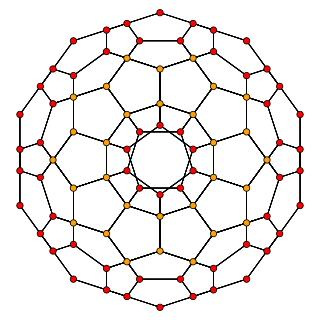
In four-dimensional geometry, a runcinated 120-cell is a convex uniform 4-polytope, being a runcination of the regular 120-cell.
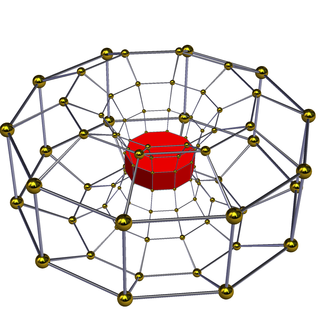
In geometry of 4 dimensions, a 10-10 duoprism or decagonal duoprism is a polygonal duoprism, a 4-polytope resulting from the Cartesian product of two decagons.

